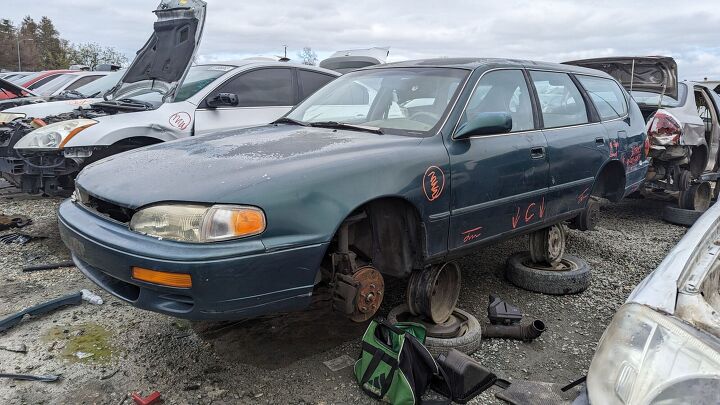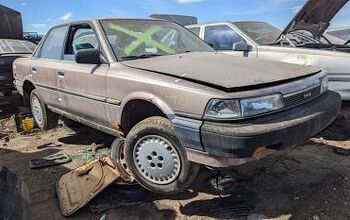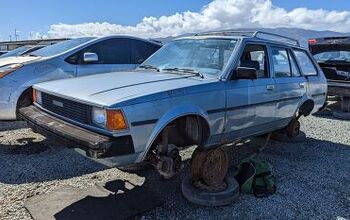Junkyard Find: 1996 Toyota Camry Wagon

Toyota sold new Camry station wagons in North America from the 1987 through 1996 model years. I've found a couple of examples of the first-year longroof Camry during my junkyard travels, but the final-year cars remained elusive… until I spotted this one in a Silicon Valley car graveyard in April.
Car shoppers on our continent had been steadily losing interest in wagons since the year of Peak Wagon (1977), with de-wagon-ification really accelerating when minivan sales took off in the 1980s and the SUV craze took full effect in the 1990s.
By 1996, Toyota showrooms had the RAV4 and the Previa to lure away potential Camry Wagon buyers, with the increasingly macho 4Runner standing by to snare those who didn't mind driving a truck with a jouncy truck ride.
Still, someone was willing to buy this car, and it stayed on the road for 27 years.
As a member of Generation X with a decidedly 1970s childhood, I'm expected to be a fanatical supporter of station wagons. However, my own family had a full-sized Chevy Beauville 3/4-ton van and no wagons during the 1970s and all of my personal wagon-owning experience derives from an assortment of cop-auction-obtained Toyota Tercels and a Subaru Outback that I married into. I don't feel much passion one way or the other for the station wagon.
That said, I think the station wagon makes more sense for most real-world applications than nearly all SUVs and most minivans, and I'm disappointed that we have shunned them so thoroughly.
This car racked up a respectable final mile count, though 226k isn't noteworthy by Camry standards. I've found several used-up Camrys with better than 300,000 miles on their odometers, including an '87 wagon with 322,110 miles.
You could get the 1996 Camry with a 188-horse V6, but this car has the base 2.2-liter four-cylinder and 125 horsepower.
New Camry sedans were still available in the United States with manual transmissions in 1996 (in fact, new manual-equipped Camry sedans could be bought here through the 2011 model year), but the last year for a three-pedal Camry wagon was 1991.
The 1992-1996 Camry wagons got these cool-looking dual rear wipers.
Room for all the accolades.
In Japan, this car was called the Scepter, and it was an American import.
[Images: The Author]
Become a TTAC insider. Get the latest news, features, TTAC takes, and everything else that gets to the truth about cars first by subscribing to our newsletter.

Murilee Martin is the pen name of Phil Greden, a writer who has lived in Minnesota, California, Georgia and (now) Colorado. He has toiled at copywriting, technical writing, junkmail writing, fiction writing and now automotive writing. He has owned many terrible vehicles and some good ones. He spends a great deal of time in self-service junkyards. These days, he writes for publications including Autoweek, Autoblog, Hagerty, The Truth About Cars and Capital One.
More by Murilee Martin
Latest Car Reviews
Read moreLatest Product Reviews
Read moreRecent Comments
- Lou_BC Well, I'd be impressed if this was in a ZR2. LOL
- Lou_BC This is my shocked face 😲 Hope formatting doesn't fook this up LOL
- Lou_BC Junior? Would that be a Beta Romeo?
- Lou_BC Gotta fix that formatting problem. What a pile of bullsh!t. Are longer posts costing TTAC money? FOOK
- Lou_BC 1.Honda: 6,334,825 vehicles potentially affected2.Ford: 6,152,6143.Kia America: 3,110,4474.Chrysler: 2,732,3985.General Motors: 2,021,0336.Nissan North America: 1,804,4437.Mercedes-Benz USA: 478,1738.Volkswagen Group of America: 453,7639.BMW of North America: 340,24910.Daimler Trucks North America: 261,959










































Comments
Join the conversation
The dual rear window wipers on the rear lift gate “quirks and features” were also used on the late 80’s early 90’s Cressida wagon.
In America, when Toyota redesigned the Camry for the 1997 model year, they discontinued the wagon. Honda would also discontinue the Accord Wagon the following year. Wagons are better than SUVs, so it is unfortunate the America doesn't get wagons anymore